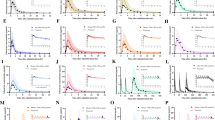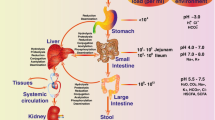Abstract
To understand the genetic makeup and impact on pharmacokinetics (PK) in the Taiwanese population, we analyzed the pharmacogenetic (PG) profile and demonstrated its effects on enzyme metabolism using indapamide as an example. A multiplex mass spectrometry method was used to examine the single nucleotide polymorphism (SNP) profile of eight major phases I and II metabolic enzymes in 1,038 Taiwanese subjects. A PG/PK study was conducted in 24 healthy subjects to investigate the possible effects of 28 SNPs on drug biotransformation. Among the genetic profile analyzed, eight SNPs from CYP2A6, CYP2C19, CYP2D6, CYP2E1, CYP3A5, and UGT2B7 showed higher variant frequencies than those previously reported in Caucasians or Africans. For instance, we observed 14.7% frequency of the SNP rs5031016 (I471T) from CYP2A6 in Taiwanese, whereas 0% variation was reported in Caucasians and Africans. The PG/PK study of indapamide demonstrated that the polymorphic SNPs CYP2C9 rs4918758 and CYP2C19 rs4244285 appeared to confer lowered enzyme activity, as indicated by increased C max (25% ∼ 64%), increased area under the plasma level-time curves (30∼76%), increased area under the time infinity (43% ∼ 80%), and lower apparent clearance values than PK for wild-type indapamide. Our results reinforce the biochemical support of CYP2C19 in indapamide metabolism and identify a possible new participating enzyme CYP2C9. The PG/PK approach contributed toward understanding the genetic makeup of different ethnic groups and associations of enzymes in drug metabolism. It could be used to identify two genetic markers that enable to differentiate subjects with varied PK outcomes of indapamide.


Similar content being viewed by others
REFERENCES
Lee C, Morton CC. Structural genomic variation and personalized medicine. N Engl J Med. 2008;358(7):740–1.
Ma MK, Woo MH, McLeod HL. Genetic basis of drug metabolism. Am J Health Syst Pharm. 2002;59(21):2061–9.
Wang KS, Zahn LE, Favor J, Huang KM, Stambolian D. Genetic and phenotypic analysis of T cm, a mutation affecting early eye development. Mamm Genome. 2005;16(5):332–43.
Sakurai Y, Hirayama M, Hashimoto M, Tanaka T, Hasegawa S, Irie S, et al. Population pharmacokinetics and proton pump inhibitory effects of intravenous lansoprazole in healthy Japanese males. Biol Pharm Bull. 2007;30(12):2238–43.
Tomalik-Scharte D, Lazar A, Fuhr U, Kirchheiner J. The clinical role of genetic polymorphisms in drug-metabolizing enzymes. Pharmacogenomics J. 2008;8(1):4–15.
Gardiner SJ, Begg EJ. Pharmacogenetics, drug-metabolizing enzymes, and clinical practice. Pharmacol Rev. 2006;58(3):521–90.
Yasuda SU, Zhang L, Huang SM. The role of ethnicity in variability in response to drugs: focus on clinical pharmacology studies. Clin Pharmacol Ther. 2008;84(3):417–23.
Lin M, Chu CC, Chang SL, Lee HL, Loo JH, Akaza T, et al. The origin of Minnan and Hakka, the so-called “Taiwanese”, inferred by HLA study. Tissue Antigens. 2001;57(3):192–9.
Pattaro C, Ruczinski I, Fallin DM, Parmigiani G. Haplotype block partitioning as a tool for dimensionality reduction in SNP association studies. BMC Genomics. 2008;9(1):405.
Sethupathy P, Giang H, Plotkin JB, Hannenhalli S. Genome-wide analysis of natural selection on human cis-elements. PLoS One. 2008;3(9):e3137.
Hunter DJ, Khoury MJ, Drazen JM. Letting the genome out of the bottle—will we get our wish? N Engl J Med. 2008;358(2):105–7.
Ding C, Jin S. High-throughput methods for SNP genotyping. Methods Mol Biol. 2009;578:245–54.
Ragoussis J. Genotyping technologies for genetic research. Annu Rev Genomics Hum Genet. 2009;10(1):117–33.
Reilly RF, Peixoto AJ, Desir GV. The evidence-based use of thiazide diuretics in hypertension and nephrolithiasis. Clin J Am Soc Nephrol. 2010;5(10):1893–903.
Chan TY. Indapamide-induced severe hyponatremia and hypokalemia. The Annals of Pharmacotherapy. 1995;29(11):1124–8.
Psaty BM, Smith NL, Siscovick DS, Koepsell TD, Weiss NS, Heckbert SR, et al. Health outcomes associated with antihypertensive therapies used as first-line agents. A systematic review and meta-analysis. JAMA J Am Med Assoc. 1997;277(9):739–45.
Campbell DB, Phillips EM. Short term effects and urinary excretion of the new diuretic, indapamide, in normal subjects. Eur J Clin Pharmacol. 1974;7(6):407–14.
Sun H, Moore C, Dansette PM, Kumar S, Halpert JR, Yost GS. Dehydrogenation of the indoline-containing drug 4-chloro-N-(2-methyl-1-indolinyl)-3-sulfamoylbenzamide (indapamide) by CYP3A4: correlation with in silico predictions. Drug Metab Dispos. 2009;37(3):672–84.
Van Hee W, Thomas J, Brems H. Indapamide in the treatment of essential arterial hypertension in the elderly. Postgrad Med J. 1981;57 Suppl 2:29–33.
Jurinke C, van den Boom D, Cantor C, Köster H. The use of MassARRAY technology for high throughput genotyping chip technology. In: Hoheisel J, Brazma A, Büssow K, Cantor C, Christians F, Chui G, et al. editors. Advances in biochemical engineering/biotechnology. Advances in biochemical engineering/biotechnology, 77. Heidelberg: Springer; 2002. p. 57–74.
Barrett JC, Fry B, Maller J, Daly MJ. Haploview: analysis and visualization of LD and haplotype maps. Bioinformatics. 2005;21(2):263–5.
Schiavi P, Jochemsen R, Guez D. Pharmacokinetics of sustained and immediate release formulations of indapamide after single and repeated oral administration in healthy volunteers. Fundam Clin Pharmacol. 2000;14(2):139–46.
Nakashima K, Narukawa M, Kanazu Y, Takeuchi M. Differences between Japan and the United States in dosages of drugs recently approved in Japan. J Clin Pharmacol. 2011;51(4):549–60.
Arnold FL, Kusama M, Ono S. Exploring differences in drug doses between Japan and Western countries. Clin Pharmacol Ther. 2010;87(6):714–20.
Kim DH, Sriharsha L, Xu W, Kamel-Reid S, Liu X, Siminovitch K, et al. Clinical relevance of a pharmacogenetic approach using multiple candidate genes to predict response and resistance to imatinib therapy in chronic myeloid leukemia. Clin Cancer Res. 2009;15(14):4750–8.
Chowbay B, Zhou S, Lee EJ. An interethnic comparison of polymorphisms of the genes encoding drug-metabolizing enzymes and drug transporters: experience in Singapore. Drug Metab Rev. 2005;37(2):327–78.
Zhou Q, Yu XM, Lin HB, Wang L, Yun QZ, Hu SN, et al. Genetic polymorphism, linkage disequilibrium, haplotype structure and novel allele analysis of CYP2C19 and CYP2D6 in Han Chinese. Pharmacogenomics J. 2009;9(6):380–94.
Kim K, Johnson JA, Derendorf H. Differences in drug pharmacokinetics between East Asians and Caucasians and the role of genetic polymorphisms. J Clin Pharmacol. 2004;44(10):1083–105.
Lin M, Chu C, Chang S, Lee H, Loo J, Akaza T, et al. The origin of Minnan and Hakka, the so-called “Taiwanese”, inferred by HLA study. Tissue Antigens. 2001;57:192–9.
Evans WE, McLeod HL. Pharmacogenomics—drug disposition, drug targets, and side effects. N Engl J Med. 2003;348(6):538–49.
Ingelman-Sundberg M, Oscarson M, McLellan RA. Polymorphic human cytochrome P450 enzymes: an opportunity for individualized drug treatment. Trends Pharmacol Sci. 1999;20(8):342–9.
Caruso FS, Szabadi RR, Vukovich RA. Pharmacokinetics and clinical pharmacology of indapamide. Am Heart J. 1983;106(1 Pt 2):212–20.
Robinson DM, Wellington K. Indapamide sustained release: a review of its use in the treatment of hypertension. Drugs. 2006;66(2):257–71.
Pedersen RS, Brasch-Andersen C, Sim SC, Bergmann TK, Halling J, Petersen MS, et al. Linkage disequilibrium between the CYP2C19*17 allele and wildtype CYP2C8 and CYP2C9 alleles: identification of CYP2C haplotypes in healthy Nordic populations. Eur J Clin Pharmacol. 2010;66(12):1199–205.
Bohanec Grabar P, Grabnar I, Rozman B, Logar D, Tomsic M, Suput D, et al. Investigation of the influence of CYP1A2 and CYP2C19 genetic polymorphism on 2-cyano-3-hydroxy-N-[4-(trifluoromethyl)phenyl]-2-butenamide (A77 1726) pharmacokinetics in leflunomide-treated patients with rheumatoid arthritis. Drug Metab Dispos. 2009;37(10):2061–8.
ACKNOWLEDGMENTS
The authors are grateful to Hung-Lun Chiang and Yie-Wen Liao at the Institute of Biomedical Sciences, Academia Sinica, for genotyping analysis. The statistical advices from Mr. Chin Lin at the School of Public Health, National Defense Medical Center, were also appreciated.
Conflict of Interest
The authors declare no conflict of interest.
Author information
Authors and Affiliations
Corresponding author
Rights and permissions
About this article
Cite this article
Wang, TH., Hsiong, CH., Ho, HT. et al. Genetic Polymorphisms of Metabolic Enzymes and the Pharmacokinetics of Indapamide in Taiwanese Subjects. AAPS J 16, 206–213 (2014). https://doi.org/10.1208/s12248-013-9535-x
Received:
Accepted:
Published:
Issue Date:
DOI: https://doi.org/10.1208/s12248-013-9535-x




